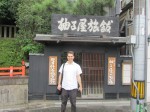Archive for the ‘Travel’ Category
Late Night Shopping in Busan
Posted on: October 24, 2010
- In: Food | Korea | Travel
- Leave a Comment
Woke up to drizzle this morning. That’s a first. It was the same weather system that disrupted the start of the F1 Grand Prix a few hundred miles down the road in Yeongam.

So we went shopping. Only kidding. We went to Shinsegae, the largest department store in the world according to the Guiness Book of Records.
Truth to tell, we didn’t do much shopping. The fourteen floors of the building house a golf driving range (floors 11 thru 14), a spa, an ice-rink, a cinema and of course a restaurant floor. Oh, and stuff you can buy.

We started at the golf and spent 40 minutes whacking golf balls in a space that has the largest carry distance of any indoor golf range in Korea.
We checked out the cinema area and the interesting-sounding concept of Cine de Chef: eating a restaurant meal while watching Michael Douglas in Wall Street 2. I don’t think so.

So it had to be the spa. The system is great. You are given a locker key and that is used to first deposit your shoes. You then proceed to reception, where you are allocated bath robes. You leave any valuables in a further set of lockers in the reception area. You then proceed to the changing room, where the same locker number is used to deposit clothes and change into your bath robes.
These robes are really a simple slip on top and pants and they’re just to enable you to wander about in the mixed-sex areas. They’re colour coded: guys in light brown and gals in crimson. And they’re styled a bit like prison tunics.
The first such area we visited was the foot bathing area. This was a series of paddling pools of different temperatures and salt composition, which reflected the naturally occurring springs that apparently exist here. One was sodium chloride, the other was sodium bicarbonate.
Then it was time to join the big boys in the main baths. Tunics were discarded and after a thorough scrub-down in the showers, we were bollock naked splashing round with about fifty other blokes. Again there were pools of varying temperatures and salt composition, saunas and steam rooms. I have to say – it was not a pretty sight.
We reclaimed our tunics after this and went for a walk around the common areas. Bars, restaurants, massage, hair cutting, areas for stretching and the Relax Bar. Here we found leather recliner seats each of which had its own flat screen TV with speakers in the chair’s head rest. And joy of joy for Nick, the F1 Grand Prix was just underway. So that was it. Beers in, a few smoked eggs and we were set.

Then another round of the bathing areas and upstairs for our last Korean meal: Bulgogi, thinly-sliced marinated beef cooked in front of us in a rather cleverly designed device which combines the features of a stew-pot and a BBQ.
In the end, we’d been there over six hours and it turns out there’s a surcharge if you go over 4 unless you buy some of their extra services. Those beers in the Relax Bar were worth their weight in gold.
Busan’s Jagalchi Fish Market
Posted on: October 24, 2010
- In: Food | Korea | Travel | Uncategorized
- Leave a Comment
The Beetle hydrofoil ferry that makes the trip to Busan in Korea took 3 hours and was pretty smooth. We dumped our baggage at the hotel and headed straight for the Jagalchi Fish Market which was nearby.
As soon as we entered the precinct of the market, we encountered women squatting on the floor cleaning shellfish.
The market building is on seven floors but it’s the ground floor where all the action is. Here are some video clips that show the immense variety of seafood on offer. Look out for the aptly-named ‘sea penises’.
On the first floor is a raw fish restaurant. It was Saturday in Busan and there were many large groups sitting cross-legged round low wooden tables having a fishy feast. Quite a bit of alcohol was being drunk as well.
We were directed to one of the tables they reserve for westerners who like to sit on chairs. Our table was soon filled with the side dishes which accompany a Korean meal. Then a grilled sardine-like fish was served, followed by a plate of Korean sashimi made up of fish recently seen swimming in the tanks adjacent to our table. A bit chewy for my taste – a very different experience from the silky tuna we ate in Tokyo. Finally, a gas burner is placed on the table and a pot of broth is allowed to bubble.
Final stop, Hakata
Posted on: October 23, 2010
- In: Food | Japan | Korea | Travel
- Leave a Comment
The end of the line for the shinkansen is Hakata, another hour onwards from Hiroshima. It’s only a brief stopover. Tomorrow we board a ferry which will take us back to Korea.

But first, a taste of the local speciality, ramen. We walked along the river front looking for street food served from market stalls, known as yatai. We were soon eating noodles steeped in a deliciously deep pork broth.

And so it’s goodbye Japan. It’s so in character for the shore staff at the ferry terminal to line up on the quayside to wave a farewell. The senior man looks at his watch. Ten o clock exactly. He gives a small nod of satisfaction.
Himeji and Hiroshima
Posted on: October 23, 2010
- In: Japan | Travel
- 2 Comments
Next stop on the shinkansen from Kobe was Himeji, famous for its magnificent castle which features in ‘You only Live Twice’ and ‘Shogun’ films.

It’s an impressive building but its main tower is currently cloaked in scaffolding for long-running renovation and so the effect is somewhat lost. We were able to walk around some of the rooms but there were no artifacts to be seen.
We didn’t hang around … so next stop Hiroshima.

This is a place that has to be seen. A short tram ride from the station takes you first to the Dome, a structure which partly survived the bomb-blast when all around was wasted.

Beyond the Dome, is the Peace Museum. This tells the story of Hiroshima – not just from the historical and political perspective.
It also portrays human stories: mothers who waited home for a child who never arrived; diaries of children written just before the explosion; the hands of a wristwatch frozen in time; a tattered garment with the biographical details of the child to whom it belonged; survivors attempting to live a life afterwards.
It also details in scientific and human terms the effects of radiation: the lethal legacy of a nuclear explosion.

The City of Hiroshima campaigns tirelessly for the abandonment of nuclear weapons. Over sixty years on, its message is as powerful as ever.
Tokyo fish market
Posted on: October 23, 2010
- In: Food | Japan | Travel
- Leave a Comment
This is a place-holder for our trip to the fish market. All attempts to edit the video so far have ended in failure.
Nishiki Market Kyoto then Kobe
Posted on: October 23, 2010
- In: Food | Japan | Travel
- Leave a Comment

Deposited our cases at Kyoto station and then caught the subway to Nishiki market.
The central walkway boasts a wonderful mix of stalls: fish and vegetables, high-quality pottery, and best of all knives.

I plumped for a beautiful carbon steel sashimi knife (which didn’t break the bank) and is now inscribed with my name in Japanese by the guy pictured.
We decided we wouldn’t stay on in Kyoto but head on down the line to Kobe. The only problem was that on our return to the station we could not find the coin locker that had our luggage. It turned out that there are two entrances to Kyoto station that look very similar. We made several passes of the extremely long station frontage before we worked out that we had to go over the tracks to the other side, by which time we missed the train for which we had reserved seats.
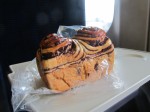
This led to another revelation: shinkansen reservations are a bit redundant in the middle of the day when there are plenty of unreserved seats. The missed train also gave us time to visit the Paul Bocuse patisserie counter at Kyoto station where we bought something for tea.
Safely arrived at out hotel, we went in search of something to eat. Beef, of course.

We had read a blogged review of a beef restaurant Mouri which had signage in Cyrillic script. We wondered whether a Russian billionaire was bankrolling the place. It turned out that it was a version of the owners name that translated as ‘Ocean’.
We couldn’t quite bring ourselves to pay the £100 per head that it would cost to eat the highest quality Kobe beef. We settled for something a little down the pecking order.

It looked a mighty fine specimen of meat which was presented to us for inspection. We then watched as our chef prepared the beef on the hot plate at our section of the bar – teppanyaki style. He fried garlic crisps, beetroot segments, beansprouts, turnip, tofu, mushroom. No meal in Japan is complete without rice, so that appeared as well with, inexplicably, a minestrone soup course beforehand.
As can be seen from the picture the marbling on the beef is considerable and accounts for the succulent taste in the mouth. It seemed a little heretical to prefer our home-grown steaks that offer a more ‘meaty’ taste – but that was our conclusion.

Our walk after dinner round Kobe was quite entertaining. Kobe is a resort town for visitors from within Japan as well as Europeans and there are countless bars. Never expected our evening to end with a game of darts on an electronic board.
Carry On Ryokan
Posted on: October 22, 2010
- In: Food | Japan | Travel
- Leave a Comment
Let’s be clear, this ryokan is designed for westerners. Well, you have to start somewhere. And anyway, the heavy-duty Japanese variety is like an exclusive club: you need a member to introduce you.
We were greeted by a guy who spoke perfect English and showed us to our room. There was a little frisson when they learned that that they were dealing with a father and son combo. A female kimono was rapidly exchanged for the male variety. And shortly afterwards, a young woman brought us tea, explain that she had learned her english in Eastbourne.
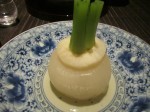

We’re booked for our kaiseki dinner at six (it takes 2 to 3 hours to complete) so that gave us time for our first fragrant yuzo bath in the public tub. Yuzo, japanese lemon, is the theme for this ryokan. Our room is named ‘Kiiro’ – yellow – and a feature of the bath was the fruit bobbing about in the continuously flowing stream of extremely hot water.

At dinner we had two retired German couples to our side. We were acknowledged but there was little meaningful conversation with them. He summed up his meal to his host by saying “So the difference between this and a German meal is that we kneel down, ha ha”. Actually we didn’t have to kneel. We had those user-friendly low tables, hollowed out underneath so that we could sit. And there was definitely no sausage. At least, not in the dishes. The occasional one did escape through our kimonos and getting up after dinner was a serious challenge to one’s dignity.

After dinner, another bath. What else. But this was not the sort of eating that leaves you bloated for which a bath would be a kind of torture. We were now in a very nice state of mind and body.
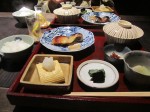
We elected for the Japanese breakfast: when in Rome etc. The fish, rice, potato, vegetable combination was satisfying. The only concession to our normal routine was to ask for a cup of coffee at the end.
So now it’s Thursday and while the UK is digesting the significance of the CSR announced yesterday, we’re off to find the market…
Morning, Kyoto
Posted on: October 21, 2010
- In: Food | Japan | Travel
- Leave a Comment
Last night – I’m over it! We’re now in downtown Kyoto and a short walk from the main trail that takes in the most popular shrines.
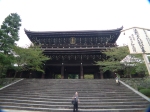
It was beginning to look like our off-season timing would spare us the tourist hoards that beat a path to this city.

What we hadn’t counted on were the masses of school parties: groups of exuberant kids processing up the narrow lanes led by a flag-waving adult. Occasionally, they’d greet me with a grin, a wave and a “Hello, how are you?” – a bit of English language field work, I guess.

It’s unfair to be blasé about the temples and shrines here but shrine fatigue did soon set in. And since we were booked into our ryokan at three, it made sense to cut the sight-seeing, grab a taxi to our hotel, pick up the luggage and have another taxi driver take us to our next destination.
From the outside, the entrance to the ryokan had no recognisable signage. We’d never have found it without the taxi driver. As soon as we climbed the steps and crossed the large stone slabs in the entrance, we were in another world.
I’m on the train …
Posted on: October 21, 2010
- In: Food | Japan | Travel
- Leave a Comment
So it’s goodbye Tokyo. Our plan today (Tuesday) is to catch the bullet train at Tokyo mainline station and head for Kyoto. But first, there’s the small matter of getting some provisions for lunch.


The the food hall to end all food halls (aka Tokyo Food Show) we clocked in Shibuya station the other day turns out to be the only one of its kind. It was the perfect place to pick up some food to go: sushi (of course), deep-fried prawns, salad and (wait for it) a scotch egg. The little blighter had a rather high egg to wrapping ratio (I hesitate to say meat) and is coated in a sticky, sweet coating.
En-route to Kyoto, Nick’s researches (on his ever-present Kindle-copy of Lonely Planet) revealed that Kyoto sight-seeing would be somewhat limited by early-closing times. A new plan was set. We’d stay on the train to Osaka, more suited for night-life.
We deposited our cases in a locker and caught the subway to Osaka aquarium, which shares its site at the harbour with a Big Wheel (not quite the biggest in the world). Happily, there a combined ticket for both attractions.

Last time I was in an aquarium, we took Barbara’s mum to Brighton Sea-life Centre, where we observed a few sea bass in a small tank. The step up to Osaka aquarium was like going from seeing Brighton play at Withdean to Barcelona at the Neucamp.
We have squillions of pictures but there’ll be video coming soon …
Oh, and that Wheel. It was now peppered with green lights against the night sky and didn’t disappoint.
There was still the small matter of getting to Kyoto and to our hotel. But it made sense to eat in Osaka first. The local food speciality is Okonomiyaki and Nick got it in his head to find a place on the way back to Osaka station. That meant a short subway ride to Namba. Now if the first night in Shinjuku was mental, Namba with its noise, neon, restaurant hustlers, and games arcades was a serious assault on the senses. A bit too much for me.
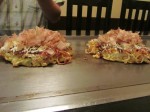
We ended up being served two pile-em-high cakes (not unlike pizza) which you cook yourself by prodding and turning on a hot plate till they’re hot and ready to eat. This was high-order stodge. Discomfort food – if there can be such a thing. Never again!
We got the hell out of there and needed subway, rail and taxi to reach our hotel for the night at 10.
Kaiseki Meal in Shinjuku
Posted on: October 20, 2010
- In: Food | Japan | Travel
- Leave a Comment
The owner of the restaurant greeted us as long-lost friends when we pitched up tonight. Her English is very good and she spent the evening patiently explaining every dish as it appeared. She even went to the trouble to show us her encyclopaedia of food so that the precise fish could be indentified.
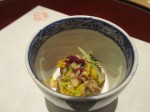
The meal starts with a tiny bowl with the most intensely flavoured fish (Samwa) together with chrysanthemum.
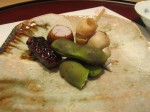
The second dish had a piece of octopus in a very sweet sticky coat, xxx beans, and a whelk in its shell

Next came snapping turtle soup an exquisitely flavoured consommé. In the centre of the dish was a white disc of silky tofu with meaty (turtle?) bits embedded. Our hostess pointed out that this was a reference to the full moon.

Now for our sushi plate – four very different experiences of fish. Mackerel which had been lightly cured in a little salt and sugar needed no further embellishment, we were told. The olive of flatfish should be dipped in soy. A sea urchin could stand alone. And the wasabi was reserved for the magnificent tuna.
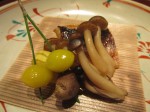
Next there was a fish dish – a Japanese barracuda we were reliably informed by reference to its picture in the encyclopaedia. It had been smoked in cedar and was joined by a few mushrooms.

Now for tempura. Three different items fried in the lightest tempura batter. Minced prawn in a wrap, a rather mild green pepper and a mushroom.

Now for a palette cleanser that tasted much better than it looked. Kuckuck (a type of seaweed) in an intense broth with some very thin noodles. The whole thing had a rather slimy texture but had a taste high on the umami scale.

I thought this was a dessert. It was a fig steamed in miso flavoured with yuzu (a Japanese lime). Interesting – but not very figgy. We did not need to be shown the picture of a fig in the big book!
No idea why it the last one had its place in the sequence because now we had another palette cleanser in the form of a rather tasteless broth in which there were pieces of fish (flounder), sesame and kondu. I can only assume the the lack of flavour is deliberate at this stage in the meal. Nevertheless, we both failed to eat more than a couple of spoons full.
And lastly some Japanese tea and a grape sorbet.
 I’d somehow expected this meal to be a bit formal and serious. In the event, the mood in the restaurant was very jolly – a reflection of the personality of our larger than life chef, Sadaharu Nakajima. He insisted on a picture in front of a sign (which had some spiritual meaning) and he drew in his wife who he described as “the owner”, then sent us on our way with goodbyes in as many languages as he could muster. Restaurant is at http://shinjuku-nakajima.com
I’d somehow expected this meal to be a bit formal and serious. In the event, the mood in the restaurant was very jolly – a reflection of the personality of our larger than life chef, Sadaharu Nakajima. He insisted on a picture in front of a sign (which had some spiritual meaning) and he drew in his wife who he described as “the owner”, then sent us on our way with goodbyes in as many languages as he could muster. Restaurant is at http://shinjuku-nakajima.com
